描述
內容簡介
觸動心靈的寓言故事
小時候,故事書經常是陪伴我們長大的忠實良伴,在成長的過程中引領著我們。好的故事會觸動心靈,並且啟發我們要讓自己和周遭的世界變得更好。故事,也會形塑我們的價值觀,而我們最終成為什麼樣的人將取決於這些價值觀。
星雲大師著《星雲說喻 中英對照版》一共六冊,讓讀者透過閱讀生動有趣的故事,探索並領悟佛陀深奧的教法和人間佛教理念。故事圍繞著佛教的「六度波羅蜜」開展,也就是菩薩道的「六度」精神:布施、持戒、忍辱、精進、禪定和般若。每篇故事以一則智慧法語作為總結,引導讀者省思個中寓意。這些故事如同一面明鏡,帶著我們檢視生活,思維如何將那永恆不朽的佛法應用在生活。
第三冊收錄十五篇以六度波羅蜜中的「忍辱」為主題的短篇故事。這是一套適合所有年齡層讀者的故事選集,本套書亦提供中英詞彙表,雙語讀者能更好理解每則故事的精髓。
期許《星雲說喻 中英對照版》能帶領讀者探索故事中無窮的慈悲、智慧與布施精神,照亮生命的道路。
Since our earliest days, stories have been faithful companions, guiding us through life’s journey. The power of a good story lies in its ability to touch our hearts, inspiring us to grow and bring positive change to ourselves and the world around us. Stories shape our perspective, and in turn, our perspective shapes who we become.
Introducing Bodhi Light Tales by Venerable Master Hsing Yun, a monumental 6-volume set available in both English and Chinese. This enchanting collection invites readers to explore the profound teachings of the Buddha and the principles of Humanistic Buddhism. Stories centered around the Six Paramitas, also known as the Six Perfections: Generosity, Precept, Patience, Diligence, Meditative Concentration, and Wisdom. Each tale in this collection is accompanied by words of wisdom, offering profound insights that encourage reflection upon the moral lessons conveyed. These stories provide a mirror through which we can examine our own lives and contemplate how these timeless teachings can be applied to our daily existence.
In this third volume, you will immerse yourself in the realm of Patience through a treasury of 15 short stories. Designed to captivate readers of all ages, this book also includes vocabulary lists to assist bilingual readers in fully understanding the essence of each tale.
May Bodhi Light Tales illuminate your path as you explore the boundless possibilities of compassion, understanding, and generosity.
★中英對照 全彩圖文 故事隨身聽 親子教育最佳教材
作者簡介
星雲大師,江蘇江都人,一九二七年生,十二歲禮志開上人為師,祖庭江蘇宜興大覺寺,傳臨濟正宗第四十八世。一九四七年於焦山佛學院畢業,期間曾參學金山、棲霞等禪淨律學諸大叢林,歷經宗下、教下、律下等完整的佛門教育。後應聘為白塔國小校長,主編《怒濤》月刊。
一九四九年春來臺,主編《人生雜誌》、《今日佛教》、《覺世》等佛教刊物。
一九六七年創建佛光山,樹立「以文化弘揚佛法,以教育培養人才,以慈善福利社會,以共修淨化人心」四大弘法宗旨,以「人間佛教」為宗風,先後在世界各地創建三百餘所道場,創辦多所美術館、圖書館、出版社、書局、人間福報、雲水醫院,興辦佛教學院十六所,中學三所,及西來、南華、佛光、南天、光明五所大學,及人間佛教研究院。
一九七O年後,相繼成立「大慈育幼院」、「仁愛之家」,收容撫育無依之幼童、老人及從事急難救濟等福利社會。一九九一年成立「國際佛光會」,被推為總會會長,實踐「佛光普照三千界,法水長流五大洲」的理想。
一九七七年編纂《佛光大藏經》、《佛光大辭典》,《中國佛教經典寶藏精選白話版》等。二O一七年出版《星雲大師全集》,共三百六十五冊,三千餘萬字,有系統地闡述人間佛教的思想、學說、理論,以及實踐結果。
二O二三年,大師住世緣盡,淨業圓滿,享耆壽九十七,被奉為佛光堂上第一代開山祖師,留遺偈:「心懷度眾慈悲願,身似法海不繫舟, 問我一生何所求,平安幸福照五洲」。
Biography of Venerable Master Hsing Yun
Venerable Master Hsing Yun was born in 1927 in Jiangdu, Jiangsu Province, China. At the age of 12, he was tonsured by Venerable Master Zhikai in Qixia Temple, Nanjing, with Dajue Temple in Yixing, Jiangsu, as his ancestral temple. He later became the 48th-generation lineage holder of the Linji Chan school. In 1947, he graduated from Jiaoshan Buddhist College, and also trained at various Chan, Pure Land, and Vinaya monasteries, including Jinshan, Qixia, and others. He received a comprehensive Buddhist education in the lineage, teachings, and Vinaya disciplines. Later on, the Venerable Master was invited to serve as the principal of Baita Elementary School, and also the editor-in-chief of Raging Billows Monthly.
In the spring of 1949, the Venerable Master arrived in Taiwan. He served as the editor-in-chief of Human Life Magazine, Buddhism Today Magazine, and Awakening the World.
In 1967, the Venerable Master founded the Fo Guang Shan Buddhist Order, with the Four Objectives: to propagate the Dharma through culture; to foster talents through education; to benefit society through charity, and to purify people’s minds through spiritual cultivation. Guided by the principles of Humanistic Buddhism, he went on to establish over three hundred temples worldwide. Additionally, he oversaw the creation of various art galleries, libraries, publishing companies, bookstores, the Merit Times newspaper, and the Cloud and Water Mobile Clinic. Furthermore, he established sixteen Buddhist colleges and founded three high schools and five universities, including the University of the West in the United States, Fo Guang University in Taiwan, Nanhua University in Taiwan, Nan Tien Institute in Australia, and Guang Ming College in the Philippines. Notably, he also established the Institute of Humanistic Buddhism.
In 1970, the Venerable Master established Da Ci Children’s Home and the Lanyang Ren Ai Senior Citizen’s Home, providing shelter and care for vulnerable young children, and elderly individuals. He also actively engaged in emergency relief efforts, contributing to the fostering of a welfare society. Then, in 1991, he founded the Buddha’s Light International Association (BLIA) and was elected as the President of the World Headquarters. Under his guidance, the association’s mission expanded, symbolized by the saying, “the Buddha’s Light shining over three thousand realms, and the Dharma water flowing continuously through the five continents.”
In 1977, the Fo Guang Buddhist Canon, the Fo Guang Dictionary of Buddhism, and the 132-volume Selected Chinese Buddhist Texts in Modern Language were compiled. In 2017, the Complete Works of Venerable Master Hsing Yun was published, comprising 365 volumes with over 30 million words, systematically expounding the ideologies, teachings, theories, and practical outcomes of Humanistic Buddhism.
In 2023, the Venerable Master peacefully passed away, his virtuous deeds complete and fulfilled, having reached the age of ninety-seven. He was revered as the Founding Master of the Fo Guang Order, and he left behind this poignant poem:
A mind with the compassionate vow to deliver sentient beings,
A body like a boat on the Dharma ocean, unbound.
Should you ask what I have achieved in this lifetime?
Peace and happiness shine upon the five continents.
目錄
Bodhi Light Tales:Volume 3
Biography of Venerable Master Hsing Yun 星雲大師簡介
Editor’s Introduction 編者序
How to Use This Book 如何使用本書
Stories
01. Cookie Fight 夫妻爭餅
02. The Turtle and the Cranes 龜與雁
03. The Two-Headed Bird 優波迦嘍嗏的瞋恨
04. The Crow’s Caw 烏鴉的聲音
05. Quit Anger 容易發怒
06. Tailor-Made 胖子學裁縫
07. The Unacceptable Gift 不收禮物
08. The Buddha and the Gong 大佛與大磬
09. Hasty Conclusion 不要衝動
10. Seeking Nothing 一無所求
11. “Water Drop” Monk 滴水和尚
12. Up in Flames 火燒城
13. The Speeding Consequence 野狼150 CC
14. The Little Novice and the Ants 長壽的沙彌
15. Embracing Patience 忍辱的美德
編者序
《星雲說喻 中英對照版》,是一套引人入勝的六冊選集,共收編了一百二十篇由敬愛的星雲大師講說、以六度波羅蜜為主題的故事。這些故事最初收錄在《星雲說喻》,大師喜歡在演講中穿插生動有趣的故事,以傳遞人間佛教思想與實踐的精髓。
2019年,我們首次將《星雲說喻》的內容翻譯成有聲故事書,並於Anchor及各大播客平台推出「菩提心燈」系列故事 (Bodhi Light Tales Podcast) 。這些年,我們一直期待著將這些故事結集成冊,如今因緣條件具足,並以中英雙語圖書的形式呈現。為了讓來自各年齡層、宗教、信仰,以及文化的讀者皆能與故事產生共鳴,我們在精簡扼要的原文基礎上發揮想像,增添了一些原文故事沒有的情節。也就是說,這套故事書中的英文故事是經過編譯的創作,非中文的直譯對照。編譯的幾項原則要點說明如下:
首先是對故事人物的背景資訊加以補充,如:名字、所從事行業,及個性等。我們蒐集文獻和查證史料,以確保人物的歷史背景正確無誤。希望藉由建構鮮明的人物特性,能帶給讀者更多親和力,也鼓勵讀者進一步探索喜愛的角色。
第二,調整文化差異的部分。例如,有一篇以「筷子」為特寫的故事,在編譯成英文時,我們將它改成「叉子」;再如,古代用來收納貴重物品的「錦囊」,在英文故事中則改以「信封」來呈現。以上改編目的,是為了加強故事元素與西方讀者日常生活之間的經驗連結。
第三,提綱挈領出每篇故事的主旨和寓意,讓讀者更容易把握住故事所要傳達的信息,引導省思。同時,也探討人們在現當代可能面臨的挑戰,幫助讀者連結所學,實際應用在日常生活之中。
故事結束,為每篇故事搭配一則精選「星雲大師法語」,作為總結故事核心寓意的智慧錦囊。「星雲大師法語」原是大師依據自己的人生經歷寫下的鼓勵和箴言,期望藉此帶給大家正念,在人生迷茫處作一盞指引方向的明燈。
學佛與否,佛性本自具足。無論是兒童還是成人,我們都有能力讓自己和周遭的世界變得更好、更正向。希望這套故事書能啟迪心性,讓各個年齡層的讀者在邁向自我覺醒的生命旅程中,充滿能量、勇氣和慈悲。
Bodhi Light Tales is a captivating 6-volume collection of stories focused on the Six Paramitas, narrated by the revered Venerable Master Hsing Yun. Originally published in Chinese as Xingyun shuoyu (星雲說喻), these Buddhist Tales by Venerable Master Hsing Yun emerged from his enlightening talks and lectures on Humanistic Buddhism. In 2019, we took the initiative to adapt these stories into English as an ongoing audiobook series for the Bodhi Light Tales Anchor Podcast channel. However, our ultimate vision has always been to present them in a book format. As the original stories were concise and lacked additional details, the English adaptations were intentionally modified from the Chinese. In essence, the English tales are not direct translations of their original Chinese counterparts. To ensure that readers of all ages, faiths, beliefs, and cultures can connect with these stories, we employed several key approaches during the transition from Chinese to English, which we will elaborate on below.
To make the main characters more relatable, we added background information such as their names, occupations, and personalities. Thorough research was conducted to maintain historical and factual accuracy. We hope this additional information will help readers delve deeper into their favorite characters and even encourage further exploration.
Furthermore, we made certain adaptations to account for cultural differences. For instance, in one of the stories, using chopsticks was originally featured, but we replaced it with forks in the English version to resonate with English-speaking readers. Similarly, silk brocade bags known as “jin nang” (錦囊) in the original tales were transformed into envelopes. These adjustments were made to ensure that the stories remain relatable to English readers.
Each tale concludes with a summary of its morals, providing readers with a clear understanding of the story’s meaning and key lessons. These summaries highlight challenges people face in today’s world and offer practical applications for daily life.
Additionally, we included Dharma Words from Venerable Master Hsing Yun at the end of each story, offering readers a final nugget of wisdom to take away. These quotes were carefully selected based on their relevance to the moral of each story. Venerable Master Hsing Yun originally shared these words of encouragement and advice based on his life experiences, aiming to inspire mindfulness and guide individuals in times of uncertainty.
Remember, Buddha-nature resides within all of us, regardless of whether we practice Buddhism or not. Both children and adults have the power to better themselves and positively impact the world around them. Our sincere hope is that these stories will inspire people of all ages, instilling in them a sense of inspiration, courage, and compassion. May this collection serve as a source of inspiration as you navigate through life’s journey toward self-awakening!
精彩試閱
The Crow’s Caw 烏鴉的聲音
有一隻烏鴉,牠經常都叫:「嗄!嗄!嗄!」牠飛到哪裡人家都討厭牠的不好聽的聲音。這隻烏鴉有一天在空中飛、飛、飛,後來停在一顆樹上,遇到了個喜鵲,喜鵲就問牠:「烏鴉你今天要飛到哪去?」烏鴉回答說:「唉!那個地方的人好討厭,一直都嫌棄我,我現在不要住在那個地方,我要飛到另外的地方去。」
喜鵲就對牠說:「烏鴉,你何必飛到別的地方去,你即使是搬到天涯海角,人家還是討厭你的,為什麼?因為你的聲音不好聽,聲音不改變,到哪裡都是一樣的命運。」
閩南語有一句話,形容一個人講話說的都是刻薄傷人的話,叫做「烏鴉嘴」,烏鴉難聽的叫聲,人家怎麼會喜歡呢?佛教的五戒裡,就有戒惡口的律法,要我們學習諸佛菩薩的柔軟愛語,給予眾生希望與信心。經典上說,佛的三十二相之一的廣長舌相,皆是多生累劫常出信心愛語,令眾生入佛知見。
烏鴉能不能變成喜鵲,只要願意改變音聲,就能改變別人對你的看法。一個優秀的藝術家,他能可以畫出山水、人物、花卉,世間一切美好的事物,因此,我們的心也如善巧的工畫師,能化現刀山劍樹的地獄相,也能變化黃金鋪地的極樂界,人只要願意用佛心去繪畫內在的世界,那麼烏鴉也能變成極樂鳥,出和雅音,晝夜念佛念法念僧。
Once upon a time, there lived a crow in a quiet village. Every day, as he flew around the village, he would greet the people with a series of “Caw! Caw! Caw!” But his caws were harsh1 and many were scared2 of him. No matter how much he tried, no one appreciated3 him.
One day, the crow flew high up into the sky. He circled in the air for a while before he got tired and decided to take a rest. He sat on a tree next to a magpie.
The magpie asked, “How are you today?”
“I’m all right…” the crow answered.
“Where are you going today?” the magpie asked again.
The crow sighed and said, “It doesn’t matter where I am going. Nobody likes me.”
“What do you mean?” the magpie asked.
“The people in my village dislike me, they always complain about how terrible4 I sound.”
“Oh, is that right?” the magpie sympathized5.
“Yeah…… that’s why I’m thinking of moving somewhere else since I’m not welcome.”
The magpie then said, “You are a crow, you should be proud of yourself.”
“No, it is because I am a crow, that is the problem! They hate the way I sound,” the crow replied.
“But even if you move to the farthest6 place, there are bound7 to be people who don’t like you,” the magpie responded.
“Oh really… then what can I do?” the crow asked.
“The thing is if you don’t deal with the core8 of the problem, no matter where you go, the problem is still there,” the magpie explained.
“What do you suggest then?” the crow asked.
“Change the way you sound!” the magpie exclaimed9.
“It is in my making! How can I change?” the crow protested10.
“Of course you can change! Running away from your problem does not solve it, you should face it. Find ways to change yourself because change starts from within,” the magpie said passionately.
In the story, whether or not the crow can ever become like the magpie, what is most important is that one is willing to change. By changing oneself and transforming the way we speak, others will change their perspective11 on us.
There is an expression in Taiwanese dialect12 when we refer to somebody’s mouth as a crow’s beak, it is to accuse someone of being a jinx13, or a bringer14 of bad luck. In Chinese culture, when your bad luck makes you think there’s a jinx on you, you are believed to be cursed15. How would anyone like that?
In Buddhism, there are the five precepts, which are:
1) Refrain from killing;
2) Refrain from stealing;
3) Refrain from sexual misconduct;
4) Refrain from lying;
5) Refrain from intake of intoxicants.
The fourth precept—refrain from lying, reminds us to guard our speech. We need to learn from the Buddhas and Bodhisattvas, learn from their gentle and loving speech which brings hope and faith to all beings. In the Buddhist sutra, it states that the Buddha has thirty-two marks of excellence16, one of them is having a long and broad tongue, which symbolizes that his words can spread far and wide. The reason why the Buddha has a long and broad tongue is because he speaks with loving-kindness and faith for countless eons17 to inspire many people to have the right views.
An outstanding artist can produce phenomenal18 drawings of landscapes19, people, flowers, and all the beautiful things in the world. These drawings are all created from the imagination20 of our complex minds. Therefore, our mind is also like a skilled craftsman, having the ability to transform our anger and ignorance into the knives and swords in hell. In contrast, our minds of goodwill can also manifest as the golden decorations
in Amitabha Buddha’s Western Pure Land. As long as we are willing to follow the Buddha’s teachings and use compassionate thoughts and minds to paint our inner world, a crow can definitely become a paradise bird, singing blissful21 music, and resonating22 with the Buddha, Dharma, and Sangha.
VOCABULARY
1. harsh (adj.) 刺耳的
2. scared (adj.) 害怕的
3. appreciated (v.) 欣賞
4. terrible (adj.) 很糟的
5. sympathized (v.) 同情
6. farthest (adj.) 最遠的
7. bound (adj.) 肯定的;極有可能的
8. core (n.) 核心
9. exclaimed (v.) 大聲說
10. protested (v.) 抗議;反對
11. perspective (n.) 觀點;想法
12. dialect (n.) 方言
13. jinx (n.) 不祥的人(或物)
14. bringer (n.) 帶來者
15. cursed (v.) 詛咒
16. marks of excellence (n.) 相好
17. eons (n.) 極長的時期
18. phenomenal (adj.) 非凡的
19. landscapes (n.) 風景;山水
20. imagination (n.) 想像力
21. blissful (adj.) 極樂的;極幸福的
22. resonating (v.) 產生共鳴
星雲大師法語
Dharma Words by Venerable Master Hsing Yun
學習布施,是改造自己慳貪的性格。
嚴持戒法,是改造自己惡性的行為。
修養忍耐,是改造自己瞋恚的惡習。
發心精進,是改造自己懈怠的因循。
修學禪定,是改造自己散亂的思想。
開發智慧,是改造自己愚癡的認知。
To transform greed, learn to be generous.
To transform unwholesome actions, observe precepts strictly.
To transform hatred, practice tolerance.
To transform laziness, vow to be diligent.
To transform discursive thinking, learn to meditate.
To transform ignorance, cultivate wisdom.
容易發怒 Quit Anger
有一位經理非常能幹,又善於領導幹部,就是脾氣大了些,常常得罪人。這個經理知道自己脾氣不好,也很想改掉壞脾氣,可是「江山易改,本性難移」,他始終無法駕馭自己的性情。苦思良久,這位經理下定決心要好好改造自己,於是找來一塊牌子,弄一條繩子掛在胸前,上面寫了「戒瞋怒」三個字,希望從此以後不再生氣。
一天,他繞道經過廠房,突然聽見兩個女工正在細語交談:「我們經理的確長得一表人才,精明能幹,心地善良,就是脾氣太壞了。」經理無意中聽到兩人的對話,禁不住勃然大怒,衝上前去痛罵一頓:「我現在已經很有修養,把瞋心都改了,為什麼你們還要在背後批評我呢?你看這個牌子,上面不是寫了戒瞋怒嗎?」
兩個不甘被罵的女工理直氣壯地說:「如果您沒有生氣,為什麼要責罵我們?」
這時,經理才領悟到自己的魯莽。
這位經理嘴上雖然說得很好聽,但是一聽到別人的批評,瞋心立刻現起,真是「說時容易,做時難」!
人所以患瞋病,就是沒有修養的工夫,遇到逆境現前,瞋心一動,馬上翻臉不認人,多年的朋友可以變成仇人,結髮的夫妻變成冤家聚頭。如果懂得「忍」,了解世間一切都是自他平等、因緣和合的,那麼瞋病便不易生起了。
我們可以換個角度思考,難道一切難以解決的問題,只要生氣就能夠化干戈為玉帛嗎?生氣只會讓事態更為嚴重,所以凡事要仔細思量,不要輕易動怒。佛說:「若以諍止諍,終不能止;唯有能忍,方能止諍。」真是至理名言!
Once upon a time, there was a cheese factory manager named William. He had managed the factory for over ten years and was a proven leader. He was a capable manager, and under his supervision, all were willing and able to perform their tasks. However, William’s only blemish1 was his quick temper2 that often offended3 and upset people.
Every year, William would receive the same feedback regarding his temper from his boss and colleagues during his performance reviews.
As it was brought up time and again, he finally realized that his temperament was something he needed to remedy4, and decided to take action. He tried very hard to stay calm and not fall prey to5 anger for three days. However, as the saying goes, “a leopard cannot change its spots.” He was unsuccessful in controlling his temper.
Disappointed in himself, he thought hard for a whole week. William made up his mind and was determined to transform himself. He brought in a signage board and wrote on it in large, capital letters, “Quit Anger!” Then, he punched6 two holes in the board, tied it with a rope, and wore it like a necklace. Arriving at work each day, William would display the board on his chest. From then on, he hoped this would serve as a constant reminder to himself and others that he shouldn’t get angry.
One day, while on his routine check of the factory, William passed one of the meeting rooms, and saw two staff members talking.At first, he didn’t think much of it, but then suddenly overheard his name being mentioned. One person said, “Indeed, William is talented, capable7, and kind, but if only he didn’t have such a bad temper.” Hearing this, William couldn’t stand it. He barged8 into the room, pointed his finger at his perceived accuser9, and yelled, “How dare you say that about me!? Look at this sign hanging from my neck! Can’t you see that I’ve quit getting angry? I’ve self-cultivated10 and have quit my anger. So why do you all still accuse me behind my back!? Stop judging me!”
After William’s outburst11 and feeling abused, the staff member courageously12 replied, “Clearly, if you had successfully quit your anger, then you wouldn’t yell at us like you just did!”
William was taken aback by the response. He realized he had yet again lost his temper.
This story highlights that making a conscious13 decision to change requires patience. It is so often much easier said than done. Although William proudly said he would quit getting angry, upon hearing others criticize14 him, he could not control himself and let his temper get the better of him.
In daily life, how often do we get angry when things do not go our way or to our liking? How often have we fallen out with someone due to our anger? Even close and old friends can become our enemies, and a loving husband and wife can become foes15.
We tend to get angry easily because we do not have self-cultivation. Self-cultivation is the development of one’s mind or capacities through one’s own efforts. It is the cultivation, integration16, and coordination17 of mind and body. It means to attempt to go beyond normal states of being, to enhance and continuously polish one’s capacities as well as potentials18. If we learn to have tolerance19, to understand that in this world, everything including you and I are equal, that all occurs from many causes and conditions, then anger will not easily arise.
Look at it from another angle, can any problem truly be solved by getting angry? Can we make peace with anger? Anger always makes matters worse, so we must think carefully before we act or respond. If we can change our perspective20 on any situation, then we will not get angry easily. The Buddha once wisely said, “If we stop an argument by arguing with others, it will never end; only with patience can the argument be stopped.”
VOCABULARY
- blemish (n.) 缺點
- temper (n.) 脾氣
- offended (v.) 冒犯
- remedy (v.) 改善
- fall prey to (phr.) 深受……折磨
- punched (v.) 穿孔
- capable (adj.) 有能力的;能幹的
- barged (v.) 闖入
- accuser (n.) 控訴者
- self-cultivated (v.) 自我修養
- outburst (n.) 爆發
- courageously (adv.) 有勇氣地
- conscious (adj.) 有意識的;自覺的
- criticize (v.) 批評
- foes (n.) 敵人
- integration (n.) 融合;合一
- coordination (n.) 調和
- potentials (n.) 潛力;潛能
- tolerance (n.) 寬容;忍受
- perspective (n.) 視角;觀點
星雲大師法語
Dharma Words by Venerable Master Hsing Yun
為人所不能為,是丈夫事業;
忍人所不能忍,是聖賢修養。
Doing the impossible is the task of great beings.
Tolerating the intolerable is the cultivation of sages.

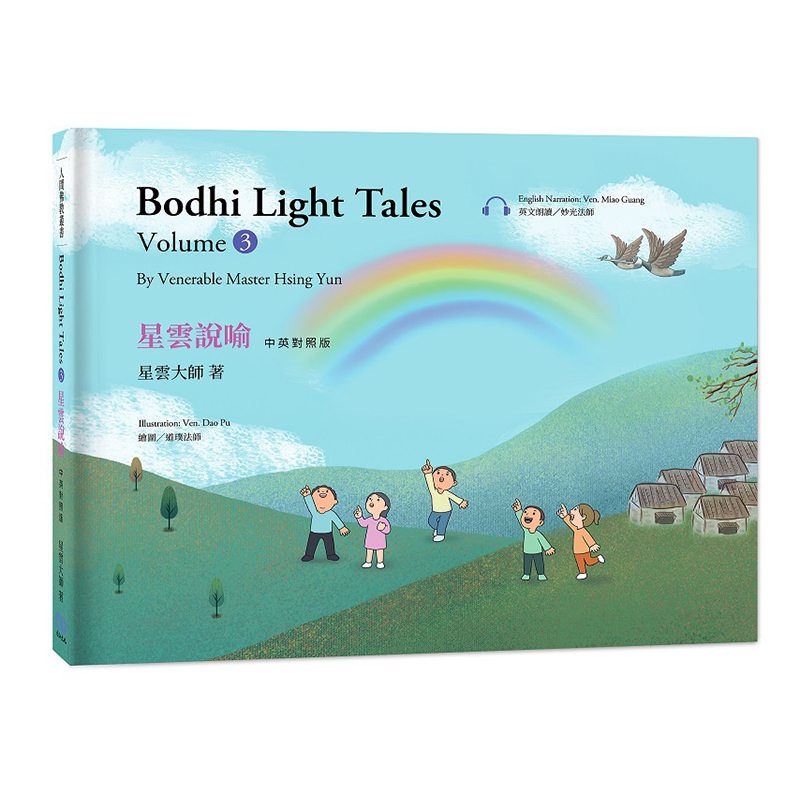
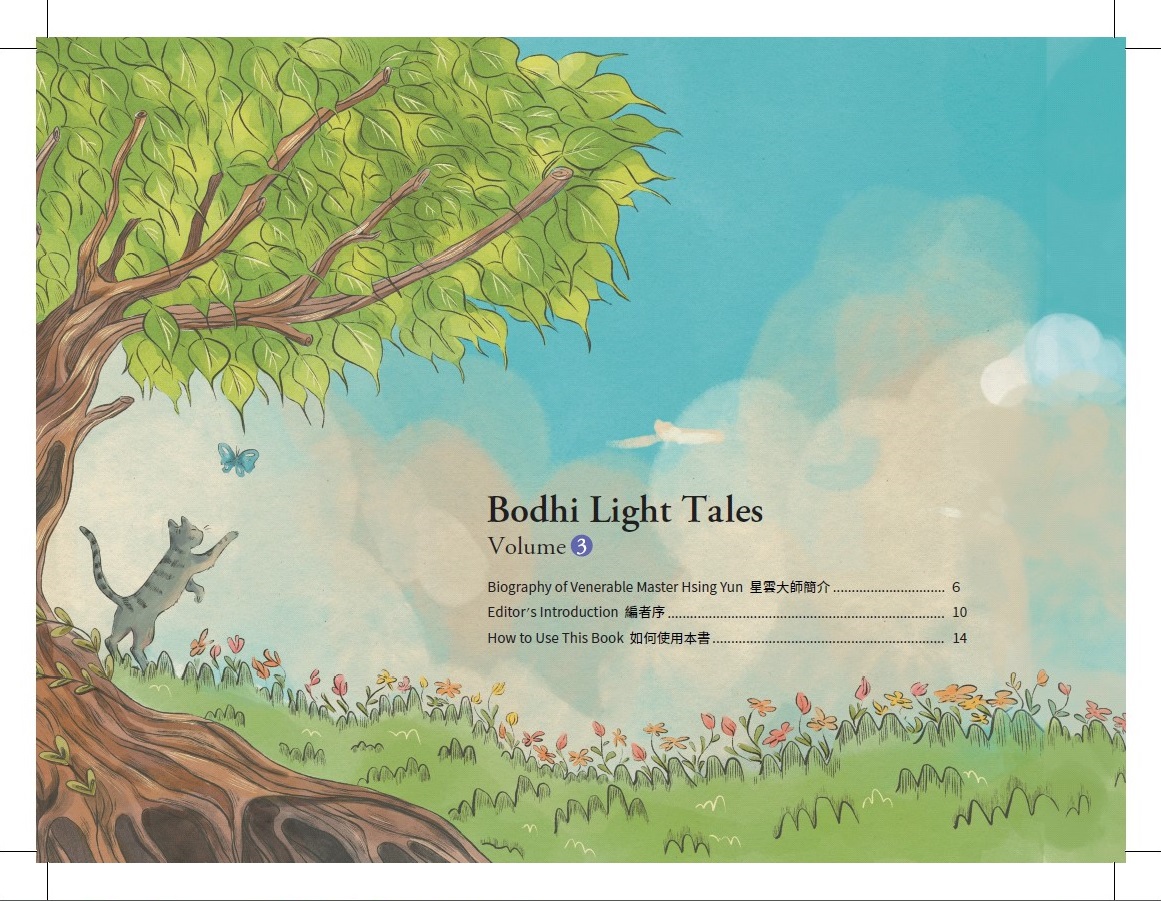


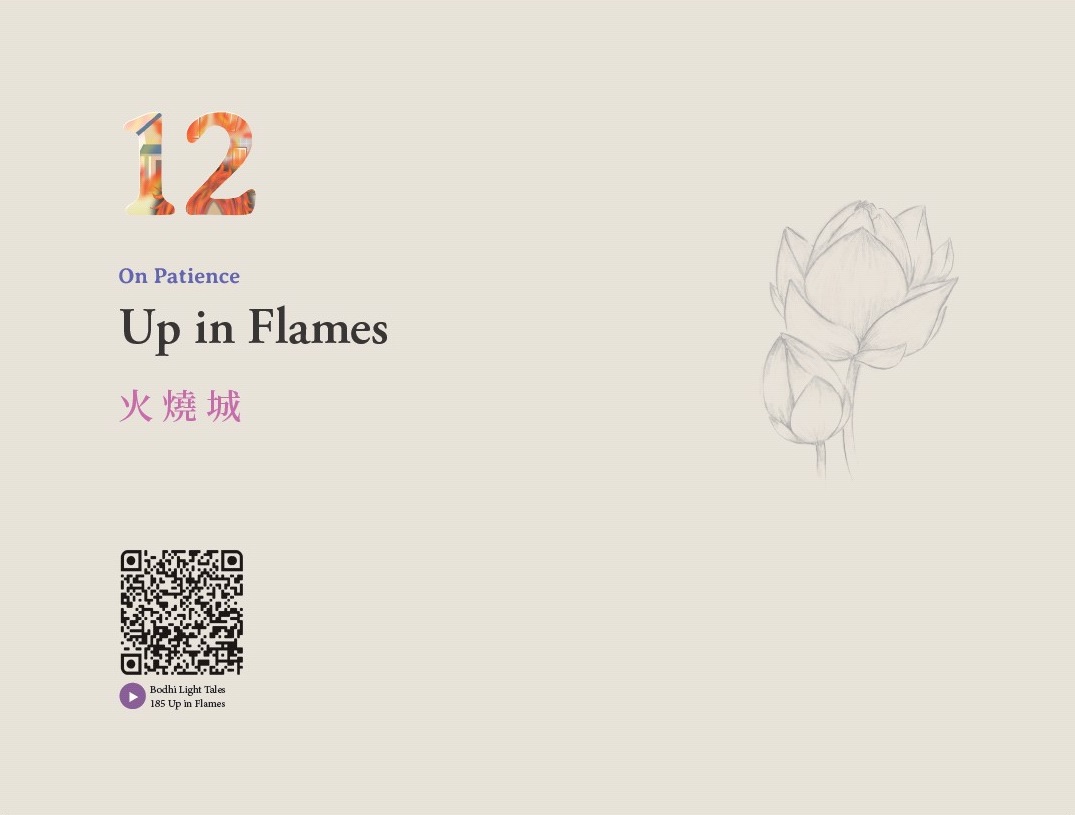
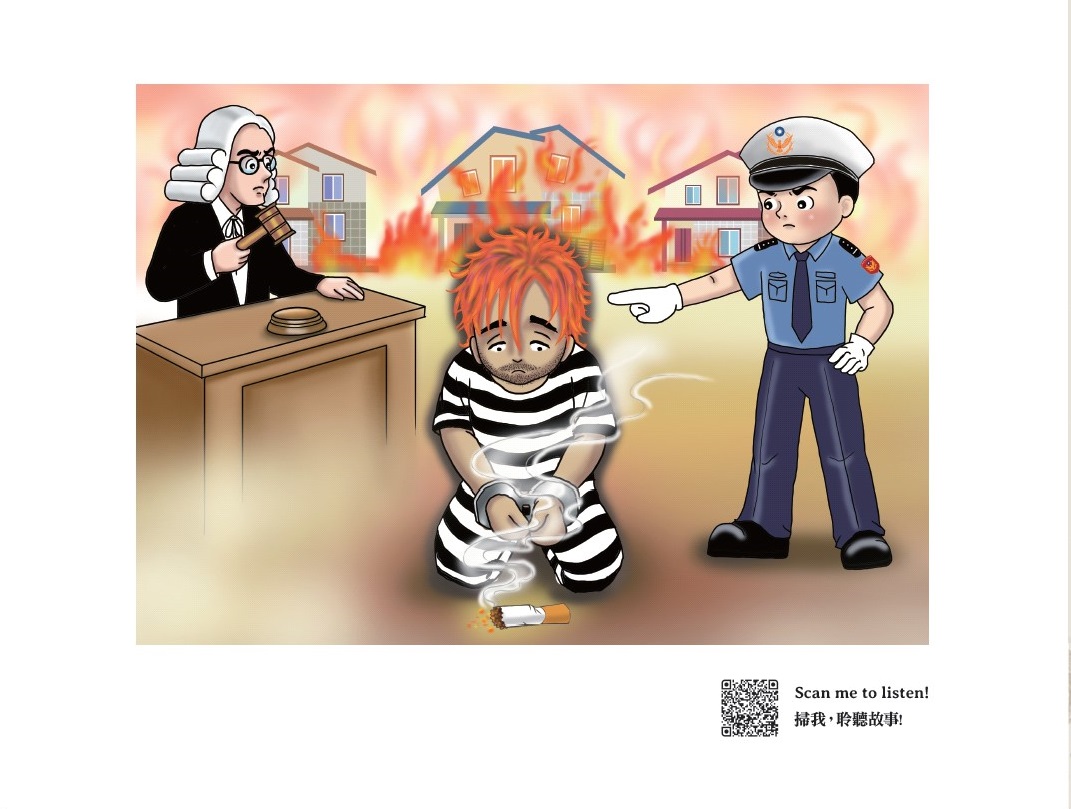
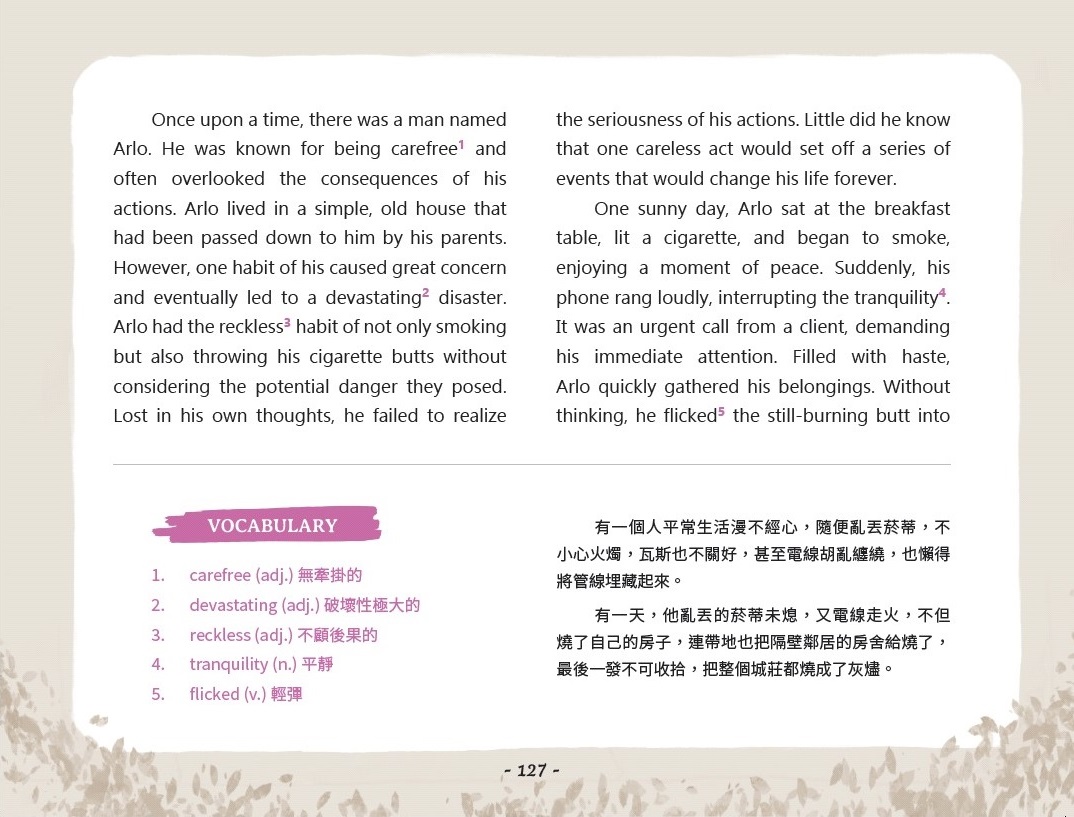


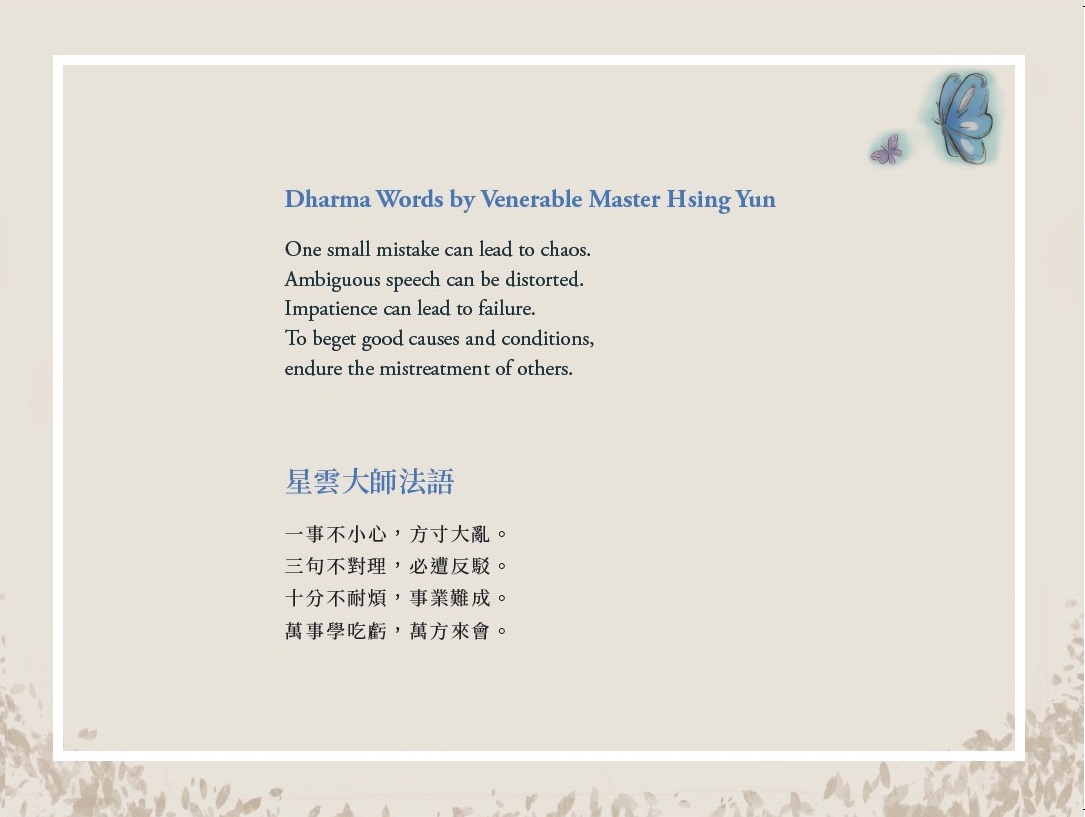
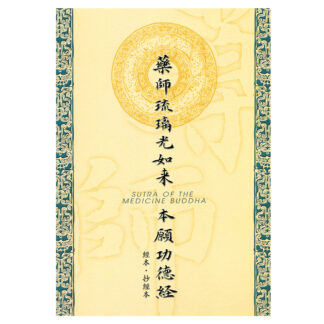

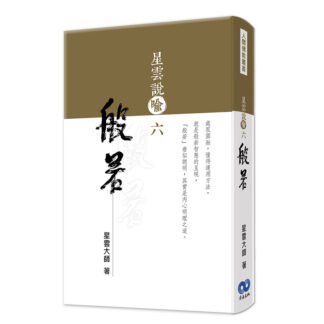
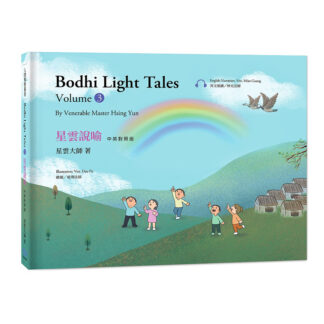
商品評價
目前沒有評價。